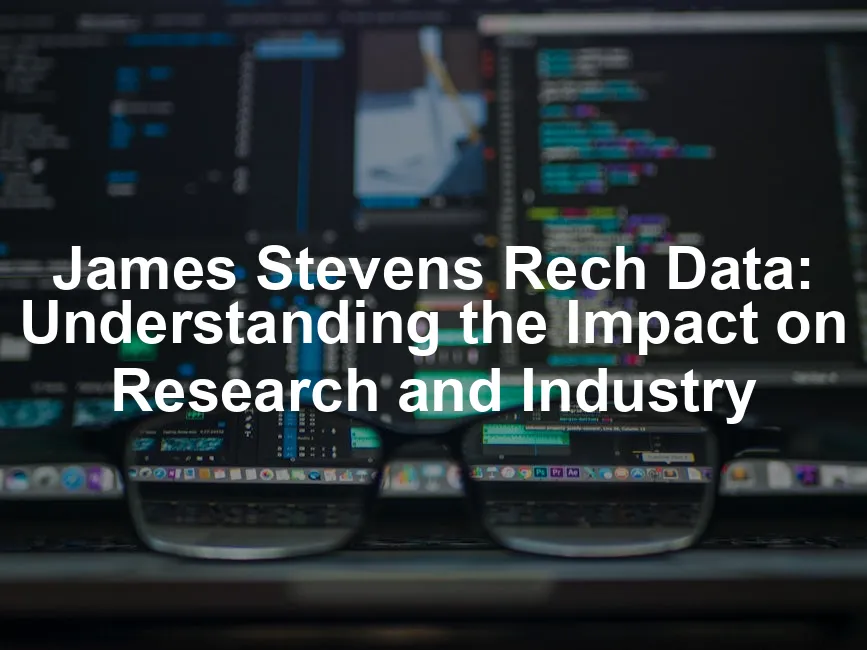Introduction
James Stevens stands out in fields like bioinformatics, finance, and technology. His work significantly influences research and industry practices. A key component of his success is “rech data,” which drives insights and advancements in his projects. In this post, we’ll cover the essence of “rech data,” its relevance to Stevens, and his contributions across various domains.
Summary and Overview
“Rech data” refers to the systematic collection and analysis of data in James Stevens’ work. This data is crucial in toxicology, finance, and open-source technology. Stevens’ career spans many impactful roles, emphasizing predictive toxicology and investment management. His findings not only enhance scientific understanding but also shape industry standards and best practices, paving the way for innovation and safety.

The Contributions of James Stevens in Toxicology
Research Interests
Dr. Stevens focuses on predictive and molecular toxicology. He has made notable strides in understanding gene expression and its relation to toxicity. His innovative approaches, such as utilizing gene expression analysis, have transformed toxicology research. These contributions help in identifying potential hazards in pharmaceuticals, ultimately leading to safer products for consumers.
Key Publications
James Stevens has authored numerous influential publications in the field of toxicology. His notable works include over 90 peer-reviewed articles, focusing on predictive and molecular toxicology. One standout publication examines gene expression as a biomarker for nephrotoxicant-induced renal injury. This research has significantly advanced our understanding of toxicity mechanisms and their implications for drug safety.
His findings are particularly relevant today. As toxicology practices evolve, Stevens’ work underscores the importance of integrating genomic data into risk assessment. This shift towards data-driven approaches enhances predictive accuracy, enabling better safety evaluations for new pharmaceuticals.
For those interested in exploring his research further, consider reading Future of Toxicology: Mechanisms of Toxicity and Drug Safety. This publication provides insights into the future directions of toxicology and the role of innovative methodologies in improving safety standards.
James Stevens and Data in Finance
Investment Strategies
As an Investment Director at Inflexion, James Stevens plays a crucial role in the mid-market sector. He specializes in originating and managing both majority and minority investments. His approach focuses on identifying high-potential businesses and fostering strong partnerships with management teams.
Stevens emphasizes a flexible investment strategy, allowing for tailored solutions that meet the unique needs of each company. This adaptability not only enhances investment outcomes but also strengthens relationships within the industry.
His expertise in finance is further highlighted through his understanding of statistical methods for finance professionals 2024, which enhances decision-making in investment strategies.
Stevens’ investment strategies are greatly informed by statistical methods, which are essential for making data-driven decisions in finance. statistical methods for finance professionals 2024
Case Studies of Successful Investments
James has successfully worked with a variety of companies, such as Blue Light Card and The Goat Agency. These collaborations have led to impressive growth and profitability. For instance, Blue Light Card, which offers discounts to emergency services, has seen significant membership increases since his investment.
Data-driven decisions are integral to Stevens’ investment philosophy. By leveraging analytics, he identifies trends and opportunities that inform strategic choices. This methodology not only boosts investment performance but also positions companies for long-term success in a competitive market.

If you’re keen on enhancing your programming skills to better understand data analytics, check out Python Crash Course: A Hands-On, Project-Based Introduction to Programming. This book is perfect for anyone looking to dive into the world of coding, making it easier to analyze and interpret data.
Open Source Contributions: The PyRar Project
Project Overview
PyRar is an innovative open-source DNS registry and registrar. It provides essential tools for domain name registration and management. Built with a Python engine, PyRar supports EPP client functionality. This makes it easy for users to register, renew, and transfer domains. The project holds a significant place in the tech community, fostering collaboration and enhancing the open-source landscape.
The significance of PyRar lies in its accessibility. It allows developers and businesses to manage domains without relying on commercial registrars. By offering a REST API and a user-friendly JavaScript web interface, PyRar streamlines domain management. This empowers users to take control of their digital assets while contributing to the open-source ethos.

For those looking to manage their digital assets more effectively, consider investing in a reliable Anker PowerCore Portable Charger. It ensures your devices stay charged while you’re on the go, making it a perfect companion for developers and tech enthusiasts.
Technical Features and Future Development
PyRar boasts a robust technical architecture based on microservices. This design allows for modularity and scalability, enhancing user experience. Currently, it operates as a single Docker container, integrating all necessary functionalities. Future versions aim to separate these functions into distinct containers, improving performance.
The project also includes features like payment options via PayPal and cryptocurrency. Users can manage their accounts easily, with automated email notifications for critical events. Upcoming enhancements focus on inbound EPP connections and better contact management. These improvements will further streamline domain transfer and renewal processes.
The Role of James Stevens in Urban Planning
Professional Background
James Stevens serves as the Director for Cities at the Home Builders Federation (HBF). In this role, he oversees urban planning matters across England, particularly regarding housing. His extensive experience in local planning has shaped housing policies significantly. He collaborates closely with local authorities to address housing challenges.
Stevens has been instrumental in developing and implementing spatial strategies in major regions. His work includes initiatives in Greater London and the Liverpool City Region. By emphasizing sustainable development, he ensures that housing meets community needs. His leadership enhances collaboration among stakeholders, driving effective urban development policies.

If you’re interested in how innovative business strategies can shape industries, I highly recommend The Lean Startup: How Today’s Entrepreneurs Use Continuous Innovation to Create Radically Successful Businesses. It’s a game-changer for anyone looking to innovate and succeed in today’s fast-paced market.
Recent Initiatives and Outcomes
James Stevens has recently spearheaded several impactful projects in urban planning. As Director for Cities at HBF, he has facilitated the development of sustainable housing policies. One notable initiative involves enhancing nutrient neutrality in building projects. This strategy addresses environmental concerns while promoting responsible construction practices.
Another significant project focuses on the implementation of innovative housing solutions in Greater London and the Liverpool City Region. These efforts aim to tackle the ongoing housing crisis by increasing the availability of affordable homes. By collaborating with local authorities, Stevens ensures that new developments align with community needs.
The implications of these initiatives extend beyond immediate housing solutions. They set a precedent for future urban planning, emphasizing sustainability and community involvement. Stevens’ leadership fosters a culture of collaboration among stakeholders, driving effective housing policies that benefit everyone.
Conclusion
James Stevens has made diverse contributions across various fields, from toxicology to urban planning. His work highlights the importance of “rech data” in advancing research and practical applications. By leveraging this data, he enhances decision-making processes that lead to safer products and better housing solutions.
Encouraging further exploration of his work reveals its profound impact. Whether in the lab or the boardroom, Stevens’ efforts shape the future of research and urban development. Dive deeper into his projects to see how they influence our communities and industries.

And if you’re a fan of strategic thinking, don’t miss out on The Art of War. It’s a timeless classic that offers insights into strategy and leadership that can be applied to any field.
What is “rech data” in the context of James Stevens’ work?
“Rech data” refers to the systematic collection and analysis of data integral to James Stevens’ research. This data informs his work in toxicology, finance, and urban planning, enhancing understanding and decision-making across these fields.
How has James Stevens impacted the field of toxicology?
James Stevens has significantly advanced toxicology through innovative research. His focus on predictive and molecular toxicology reshapes how we understand chemical safety. He pioneered the use of gene expression analysis to assess toxicity. This approach has become standard practice in the field. His influential publications, like the one on kidney injury biomarkers, highlight toxicity mechanisms. These contributions have led to safer drug development processes. Stevens’ work is vital for regulatory agencies and pharmaceutical companies alike. By integrating data analytics into toxicology, he enhances risk assessment methods. Overall, his research not only informs scientific understanding but also impacts public health and safety.
What are the future developments planned for the PyRar project?
The PyRar project is set for exciting enhancements. Future developments will focus on improving user experience and functionality. One key feature is the separation of its functionalities into distinct microservices. This will increase performance and allow for easier updates. Additionally, the team plans to implement inbound EPP connections. This enhancement will streamline domain transfers and renewals. They also aim to refine contact management for better user account handling. As the project evolves, it will include more payment options, including cryptocurrencies. These advancements will solidify PyRar’s position in the open-source community while ensuring user satisfaction.
How does James Stevens approach investment strategies?
James Stevens employs a data-driven approach to investment strategies. He focuses on identifying high-potential businesses in the mid-market sector. His methodology emphasizes flexibility, allowing for tailored solutions that meet unique company needs. Stevens leverages analytics to spot trends and opportunities. This data-driven insight informs his strategic decisions, enhancing investment performance. He values strong partnerships with management teams, fostering collaboration for growth. Overall, his investment strategies balance risk and opportunity effectively, positioning companies for long-term success.
What role does James Stevens play in urban planning?
In urban planning, James Stevens serves as the Director for Cities at the Home Builders Federation (HBF). He oversees housing policies and spatial strategies across England. His expertise in local planning shapes sustainable development initiatives. Stevens has been pivotal in addressing housing challenges in key regions. He collaborates with local authorities to enhance urban planning efforts. His recent focus includes nutrient neutrality in housing projects, promoting environmental responsibility. Through his leadership, Stevens fosters collaboration among various stakeholders. His contributions are crucial for developing effective urban policies that benefit communities.
Please let us know what you think about our content by leaving a comment down below!
Thank you for reading till here 🙂
All images from Pexels




